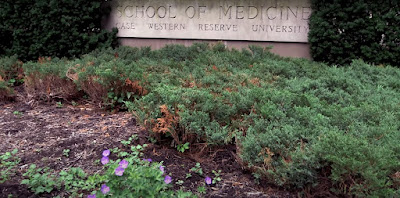Rosalind Franklin University of Medicine and Science: Tuition and Fees, Clinical Training, Social Life and Real Estate Program
Rosalind Franklin University of Medicine and Science has the distinction of having as one of its major clinical sites Cook County Hospital, the location on which the television show E.R. is based. Although the Medical School is located in North Chicago, a 45 minute drive from downtown Chicago, many students live in Chicago itself, and the School serves a diverse population of patients in Chicago, North Chicago, and other surrounding suburbs.
The new Student Learning Resource Center has an impressive library and computer facility, which many first year classes use to provide additional study material such as histology and neuroscience slides. Professors maintain an open door policy and heed student concerns. Because Rosalind Franklin Medical School emphasizes education over research, students are never overlooked. Classes are graded on a scale of A, B, C, and F, which fosters competition. Students are usually given a day between each different subject exam.
An integral part of the first and second year curriculum is the Introduction to Clinical Medicine (ICM). This class uses the classroom and outside physician preceptors to teach students the proper techniques of history taking and physical examination at various hospital sites and offices. Students own a stethoscope and a sphygmomanometer. More important, they learn that sphygmomanometer is a fancy word for blood pressure cuff and they learn how to use it. In the second year, students examine real patients in preparation for third year clerkships.
During the summer between first and second year, some students choose to vacation, while others seek employment to offset mounting debt. Students can do research on a CMS summer research fellowship, serve as a teaching assistant for gross anatomy, work toward a master's in pathology, shadow a physician, or observe the emergency room at Mount Sinai Hospital, a Level 1 trauma center for the city of Chicago.
The second year is much like the first, but most students find it far more interesting because pharmacology, pathology, and microbiology become more patient oriented. One strength at CMS is pathology, which is taught by the coauthors of the Board Review Series for Pathology (Williams & Wilkins). In addition, CMS emphasizes teaching that prepares students for board e.xams. Students are also given three to four weeks off to study before the USMLE Step 1.
Required third year rotations are emergency medicine, family medicine, medicine, medicine core, obstetrics and gynecology, pediatrics, psychiatry, surgery, neurology, and ambulatory care. Teaching hospital affiliations include Cook County Hospital, Illinois Masonic Medical Center, Edward Hines Veterans Administration Medical Center, Lutheran General Hospital, Mount Sinai Hospital and Medical Center, North Chicago Veterans Administration Medical Center, Norwalk Hospital (a private hospital in Connecticut), Swedish Covenant Hospital, and Henry Ford Hospital. Students can apply to spend several rotations or the entire third year at Henry Ford, which is located in Detroit, Michigan.
Surgery is an outstanding rotation at all sites, although the experience varies between sites, as it does for all clerskships. For example, students who complete surgery at Lutheran General Hospital miss out on trauma experience, but they also escape call responsibilities.
Emergency medicine is a standout rotation. Students rotate through the Cook County emergency room or the Mount Sinai Hospital emergency room, both Level I trauma centers, for four weeks during their third year. "See one, do one, teach one" is the prevailing educational philosophy here.
Fourth year is very flexible and allows students to prepare for USMLE Step II and gather their materials for residency applications. Students are required to take a four week medical subinternship and four weeks in a primary care setting. Fourteen weeks are designated for electives at Rosalind Franklin University of Medicine and Science affiliated hospitals, while another fourteen weeks are also allowed for externships and electives at other sites. Sports medicine, urogynecology, and surgical critical care are only a few of the electives offered at CMS. The Office for Student Affairs (OSA) makes counseling students and preparing them for the match a priority throughout the first three years.
Living for four years in the Chicago area allows students the opportunity to take advantage of the city's rich cultural diversity, including its museums, theater, and historic sites. Chicago is filled with young professionals, and there are plenty of clubs, bars, and sporting events. A student run intramural sports league is also popular. The Rosalind Franklin University Medical School Student Council provides guidance and structure for more than twenty five student run clubs and organizations.
Web https://www.rosalindfranklin.edu/
Tuition and Fees
How much does Chicago Medical School usually cost?
The tuition fee is $ 56,500-$ 62,700 per year.Preclinical Years
Classes begin at a snail s pace. Most students take advantage of the start of first semester to go downtown, explore Chicago, party, and collect their thoughts. About three weeks into the academic year, gross anatomy starts, with 5 to 6 hours of class a day. Fortunately, most Chicago Medical School departments prepare class notes that are distributed at the beginning of each semester. A student run transcript service is also usually available for those classes without department notes. The combination makes most classes optional.The new Student Learning Resource Center has an impressive library and computer facility, which many first year classes use to provide additional study material such as histology and neuroscience slides. Professors maintain an open door policy and heed student concerns. Because Rosalind Franklin Medical School emphasizes education over research, students are never overlooked. Classes are graded on a scale of A, B, C, and F, which fosters competition. Students are usually given a day between each different subject exam.
An integral part of the first and second year curriculum is the Introduction to Clinical Medicine (ICM). This class uses the classroom and outside physician preceptors to teach students the proper techniques of history taking and physical examination at various hospital sites and offices. Students own a stethoscope and a sphygmomanometer. More important, they learn that sphygmomanometer is a fancy word for blood pressure cuff and they learn how to use it. In the second year, students examine real patients in preparation for third year clerkships.
During the summer between first and second year, some students choose to vacation, while others seek employment to offset mounting debt. Students can do research on a CMS summer research fellowship, serve as a teaching assistant for gross anatomy, work toward a master's in pathology, shadow a physician, or observe the emergency room at Mount Sinai Hospital, a Level 1 trauma center for the city of Chicago.
The second year is much like the first, but most students find it far more interesting because pharmacology, pathology, and microbiology become more patient oriented. One strength at CMS is pathology, which is taught by the coauthors of the Board Review Series for Pathology (Williams & Wilkins). In addition, CMS emphasizes teaching that prepares students for board e.xams. Students are also given three to four weeks off to study before the USMLE Step 1.
Clinical Training
Third and fourth year is when Chicago Medical School shines. Students draw blood, start IV's, place central lines, place arterial Lines, close at the end of surgical procedures, reduce fractures, place and remove chest tubes, and intubate patients, all accompanied by a commitment to teaching from attendings and residents.Required third year rotations are emergency medicine, family medicine, medicine, medicine core, obstetrics and gynecology, pediatrics, psychiatry, surgery, neurology, and ambulatory care. Teaching hospital affiliations include Cook County Hospital, Illinois Masonic Medical Center, Edward Hines Veterans Administration Medical Center, Lutheran General Hospital, Mount Sinai Hospital and Medical Center, North Chicago Veterans Administration Medical Center, Norwalk Hospital (a private hospital in Connecticut), Swedish Covenant Hospital, and Henry Ford Hospital. Students can apply to spend several rotations or the entire third year at Henry Ford, which is located in Detroit, Michigan.
Surgery is an outstanding rotation at all sites, although the experience varies between sites, as it does for all clerskships. For example, students who complete surgery at Lutheran General Hospital miss out on trauma experience, but they also escape call responsibilities.
Emergency medicine is a standout rotation. Students rotate through the Cook County emergency room or the Mount Sinai Hospital emergency room, both Level I trauma centers, for four weeks during their third year. "See one, do one, teach one" is the prevailing educational philosophy here.
Fourth year is very flexible and allows students to prepare for USMLE Step II and gather their materials for residency applications. Students are required to take a four week medical subinternship and four weeks in a primary care setting. Fourteen weeks are designated for electives at Rosalind Franklin University of Medicine and Science affiliated hospitals, while another fourteen weeks are also allowed for externships and electives at other sites. Sports medicine, urogynecology, and surgical critical care are only a few of the electives offered at CMS. The Office for Student Affairs (OSA) makes counseling students and preparing them for the match a priority throughout the first three years.
Social Life
Students at RFU/CMS are graduates of a wide array of undergraduate institutions. The class of 2002 comprises sixty eight women and 112 men, who range in age from 20 to 56 and come from twenty five different states.
Living for four years in the Chicago area allows students the opportunity to take advantage of the city's rich cultural diversity, including its museums, theater, and historic sites. Chicago is filled with young professionals, and there are plenty of clubs, bars, and sporting events. A student run intramural sports league is also popular. The Rosalind Franklin University Medical School Student Council provides guidance and structure for more than twenty five student run clubs and organizations.
Real Estate Program
Most students live in the Woodlands, an apartment complex adjacent to the School. One bedroom apartments range from $849 to $989 and twobedrooms range from $949 to $1139. Others live in Chicago or Evanston, all within convenient driving distances.CHICAGO MEDICAL STUDENT LIFE
Final Thoughts
Rosalind Franklin University of Medicine and Science, despite the hefty price tag, turns well rounded students into well rounded physicians, thanks to extensive hands on training and outstanding clinical exposure.Web https://www.rosalindfranklin.edu/





















Comments
Post a Comment